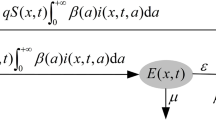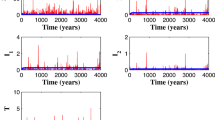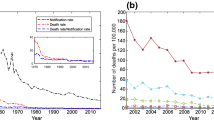Abstract
Tuberculosis is a global disease with much significant impact. Well over two million deaths are recorded each year due to Mycobacterium tuberculosis. The work by Colijn et al. (J Theor Biol 247, 765–774, 2007) examined two mathematical models (delay differential equation and network models) that explored the role of the contact structure of the population and found that in declining epidemics, localized outbreaks may occur as a result of contact heterogeneities even in the absence of host or strain variability. In this work, we carry out several qualitative studies (including the use of Sturm sequences for obtaining conditions on bifurcations) on the differential equation model with a time delay in Ref. Colijn et al., J Theor Biol 247, 765–774 (2007), and explicitly obtain threshold conditions for disease eradication as well as existence of bifurcations depending on a critical delay value which characterize the duration of fast latency. Further analysis showed the existence of a transcritical bifurcation when the reproduction number was less than one with the disease-free equilibrium co-existing with just one endemic state that was shown to be stable; the period of fast latency and the reinfection progression rate were shown to be very significant in the dynamics of the disease viz a viz the individuals who progressed to active TB within 5 years of their infection.


Similar content being viewed by others
References
Blower, S.M., Small, P.M., Hopwell, P.C.: Control strategies for tuberculosis epidemics: new models for old problems. Science 273, 497 (1996)
Bodnar, M.: The nonnegativity of solutions of delay differential equations. Appl. Math. Lett. 13, 91–95 (2000)
Castillo-Chavez, C., Feng, Z.: To treat or not to treat: the case of tuberculosis. J. Math. Biol. 35, 629 (1997)
Centers for Disease Control and Prevention.: Core Curriculum on Tuberculosis: What the Clinician Should Know. US Department of Health and Human Services, Atlanta (1994)
Colijn, C., Cohen, T., Murray, M.: Emergent heterogeneity in declining tuberculosis epidemics. J. Theor. Biol. 247, 765–774 (2007)
El’sgol’ts, L.E., Norkin, S.B.: An Introduction to the Theory and Application of Differential Equations with Deviating Arguments. Academic Press, San Diego (1973)
Feng, Z., Castillo-Chavez, C., Capurro, A.F.: A model for tuberculosis with exogenous reinfection. Theor. Popul. Biol. 57, 235 (2000)
Feng, Z., Castillo-Chavez, C., Capurro, A.F.: On the role of variable latent periods in mathematical models for tuberculosis. J. Dyn. Differ. Equ. 13(2), 425–452 (2001)
Flynn, J.L., Chan, J.: Tuberculosis: Latency and Reactivation. Infect. Immun. 69(7), 4195–4201 (2001)
Forde, J., Nelson, P.: Applications of Sturm sequencies to bifurcation analysis of delay differential equation models. J. Math. Anal. Appl. 300, 273–284 (2004)
Genik, L., van den Driessche, P.: An epidemic model with recruitment–death demographics and discreet delays. Fields Inst. Commun. 21, 238–249 (1991)
Kribs-Zaleta, C.M.: Structured models for heterosexual disease transmission. Math. Biosci. 160, 83 (1999)
Kribs-Zaleta, C.M., Velasco-Hernandez, J.X.: A simple vaccination model with multiple endemic state. Math. Biosci. 164, 183–201 (2000)
Magombedze, G., Garira, W., Mwenje, E.: Modelling the human immune response mechanisms to Mycobacterium tuberculosis infection in the lungs. Math. Biosci. Eng. 3(4), 661–682 (2006)
Mukandavire, Z., Garira, W., Chiyaka, C.: Asymptotic properties of an HIV/AIDS model with a time delay. J. Math. Anal. Appl. 330, 916–933 (2007)
Murphy, B., Singer, B., Anderson, S., Kirschner, D.: Comparing epidemic tuberculosis in demographically distinct heterogeneous populations. Math. Biosci. 180, 161–185 (2002)
Okuonghae, D., Aihie, V.: Case detection and direct observation therapy strategy (DOTS) in Nigeria: its effect on TB dynamics. J. Biol. Syst. 16(1), 1–31 (2008)
Okuonghae, D., Korobeinikov, A.: Dynamics of tuberculosis: the effect of direct observation therapy strategy (DOTS) in Nigeria. Math. Model. Nat. Phenom. 2(1), 113–128 (2007)
Okuonghae, D., Omosigho, S.E.: Analysis of a mathematical model for tuberculosis: what could be done to increase case detection. J. Theor. Biol. 269, 31–45 (2011)
Prestel, A., Delzell, C.N.: Positive Polynomials: From Hilbert’s 17th Problem to Real Algebra. Springer, Berlin (2001)
Raffalii, J., Sepkowitz, K.A., Armstrong, D.: Community-based outbreaks of tuberculosis. Arch. Int. Med. 156, 1053 (1996)
Schluger, N.W., Rom, W.N.: The host immune response to tuberculosis. Am. J. Respir. Crit. Care. Med. 157, 679–691 (1998)
Smith, H.L.: Monotone Dynamical Systems: An Introduction to the Theory of Competitive and Cooperative Systems. American Mathematical Society, Providence (1995)
Song, B., Castillo-Chavez, C., Aparicio, J.P.: Tuberculosis models with fast and slow dynamics: the role of close and casual contacts. Math. Biosci. 180, 187–205 (2002)
Ssematimba, A., Mugisha, J.Y.T., Luboobi, L.S.: Mathematical Models for the Dynamics of tuberculosis in density-dependent populations: the case of internally displaced peoples’ camps (IDPCs) in Uganda. J. Math. Stat. 1(3), 217–224 (2005)
Styblo, K.: Recdent advances in epidemiological research in tuberculosis. Adv. Tuberc. Res. 20, 1–63 (1980)
Valway, S., Sanchez, M., Shinnick, T., Orme, I., Agerton, T., Hoy, D., Jones, J., Westmoreland, H., Onorato, I.: An outbreak involving extensive transmission of a virulent strain of Mycobacterium tuberculosis. N. Engl. J. Med. 338(10), 633–639 (1998)
World Health Organization (WHO).: Global Tuberculosis Program. World Health Organization, Geneva (1997)
Author information
Authors and Affiliations
Corresponding author
Appendices
Appendix A
Sturm sequences are obtained by the division algorithm thus: Let \(f\) be a polynomial assumed not having repeated roots. Let \(f=f_0\), \(f'=f_1\). The sequences then becomes \(f_0=q_0f_1 - f_2\), \(f_1=q_1f_2 - f_3\),..., \(f_{s-2}=q_{s-2}f_{s-1} - k\), where k is a constant. To determine the number of real roots of the polynomial in a given interval, plug in each end point of the interval, and obtain a sequence of signs. The number of real roots in the interval is the difference between the number of sign changes in the sequence at each end point. A complete proof of the method of Sturm sequences can be seen in [20].
Appendix B
The coefficient of the polynomial for the endemic state for I, given in (5), and reproduced below
is given below:
where \(z=\mathrm{e}^{-\mu \tau }\hbox { and }x_5=r+\mu _{TB}+r_{TR}\).
Rights and permissions
About this article
Cite this article
Okuonghae, D. A Note on Some Qualitative Properties of a Tuberculosis Differential Equation Model with a Time Delay. Differ Equ Dyn Syst 23, 181–194 (2015). https://doi.org/10.1007/s12591-013-0190-6
Published:
Issue Date:
DOI: https://doi.org/10.1007/s12591-013-0190-6




